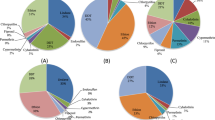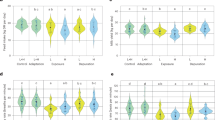Abstract
This study measured 21 persistent, bioaccumulative, and toxic (PBT) pollutants in the US milk supply. Since milk fat is likely to be among the highest dietary sources of exposure to PBTs, it is important to understand their levels in this food. Nationwide samples were collected from 45 dairy plants in July of 2000 and again in January 2001. The levels of all chemicals in the chlorobenzene, pesticide and other halogenated organic groups were determined to be below their detection limits in all samples. National averages were computed for 11 chemicals or chemical groups found above the detection limits. The national average CDD/CDF and PCB TEQ concentrations were 14.30 and 8.64 pg/l, respectively, for a total of 22.94 pg/l. These levels are about half the values found in a similar study conducted in 1996. If this difference is in fact indicative of declining milk levels and assuming exposure levels from nondairy pathways have remained the same over this time period, this would result in an overall decrease in adult background dioxin exposure of 14%. Six PAHs were detected with national averages ranging from 40 to 777 ng/l. Cadmium concentrations ranged from 150 to 870 ng/l with a national average of 360 ng/l. Lead concentrations were consistently higher than those of cadmium, ranging from 630 to 1950 ng/l with a national average of 830 ng/l. PAHs showed the strongest seasonal/geographic differences, with higher levels in winter than summer, north than south and east than west. Average adult daily intakes from total milk fat ingestion were computed for all detected compounds and compared to total intakes from all pathways: CDD/CDF/PCB TEQs: 8 vs. 55 pg/day, PAHs: 0.6 vs. 3 μg/day, lead: 0.14 vs. 4–6 μg/day, and cadmium: 0.06 vs. 30 μg/day.
This is a preview of subscription content, access via your institution
Access options
Subscribe to this journal
Receive 6 print issues and online access
$259.00 per year
only $43.17 per issue
Buy this article
- Purchase on Springer Link
- Instant access to full article PDF
Prices may be subject to local taxes which are calculated during checkout




Similar content being viewed by others
References
Agency for Toxic Substances and Disease Registry (ATSDR). Toxicological Profile for Polycyclic Aromatic Hydrocarbons (PAHs). US Department of Health and Human Services, Public Health Service. Atlanta, GA, 1995.
Agency for Toxic Substances and Disease Registry (ATSDR). Toxicological Profile for Lead. US Department of Health and Human Services, Public Health Service, Atlanta, GA, 1999a.
Agency for Toxic Substances and Disease Registry (ATSDR). Toxicological Profile for Cadmium. US Department of Health and Human Services, Public Health Service, Atlanta, GA, 1999b.
Chuang J.C., Lyu C.W., Chou Y.-L., Callahan P.J., Nishioka M., Andrews K., Pollard M.A., Brackney L., Hines C., Davis D.B. and Menton R.G . Evaluation and Application of Methods for Estimating Children's Exposure to Persistent Organic Pollutants in Multiple Media, (Vols I–III) EPA/600/R-98/164 a, b, and c, Washington, DC, 1999.
Ferrario J.B., Byrne C. and Dupuy A . Background contamination by coplanar polychlorinated biphenyls (PCBs) in trace level high resolution gas chromatography/high resolution mass spectrometry (HRGC/HRMS) analytical procedures. Chemosphere 1997: 34(11): 2451–2465.
Ferrario J.B., Byrne C., McDaniel D., Dupuy A. and Harless R . Determination of 2,3,7,8,-chlorine substituted dibenzo-p-dioxins and -furans at the parts-per-trillion level in United States beef fat using HRGC/HRMS. Anal Chem 1996: 68(4): 647–652.
Lorber M.N., Winters D.L., Griggs J., Cook R., Baker S., Ferrario J., Byrne C., Dupuy A. and Schaum J . A national survey of dioxin-like compounds in the United States milk supply. Organohal Comp, 1998: 38: 125–129.
USDA. Pesticide Data Program — Annual Summary Calendar Year, 1998.
USEPA (Environmental Protection Agency). Environmental Radiation Ambient Monitoring System (ERAMS) manual. Eastern Environmental Radiation Facility, Office of Radiation Programs; EPA 520/5-84-007,008,009, 1988.
USEPA. SW-846: test methods for evaluating solid waste. Physical/Chemical Methods 3rd edn. Method 6020, “Metals by ICP/MS”, USEPA, Washington, DC, 1994.
USEPA. SW-846: test methods for evaluating solid waste. Physical/Chemical Methods, 3rd edn. Method 3050B, “Acid Digestion of Sediment, Sludges and Soils”, USEPA, Washington, DC, 1996.
USEPA. Exposure Factors Handbook. EPA/600/P-95/002Fb, USEPA, Washington, DC, 1997.
USEPA. Dioxin reassessment — SAB review Draft. Exposure and human health reassessment exposure and human health reassessment of 2,3,7,8-TCDD and related compounds. Part I: estimating exposure to dioxin-like. Vol. 3: Properties, Environmental Levels, and Background Exposures. EPA/600/P-00/001Bc, USEPA, Washington, DC, 2000.
Van den Berg M., Birnbaum L., Bosveld A.T.C., Bronstrom B., Cook P., Feely M., Giesy J.P., Hanberg A., Hasegawa R., Kennedy S.W., Kubiak T., Larsen J.C., Van Leeuwen F.X.R., Liem A.K.D., Nort C., Peterson R.E., Poellinger L., Safe S., Schrenk D., Tillitt D., Tysklind M., Younes M., Waern F., Sacherewski T . Toxic equivalency factors (TEFs) for PCBs, PCDDs, PCDFs for humans and wildlife. Environ Health Perspect 1998: 106(12): 775–792.
Author information
Authors and Affiliations
Corresponding author
Rights and permissions
About this article
Cite this article
Schaum, J., Schuda, L., Wu, C. et al. A national survey of persistent, bioaccumulative, and toxic (PBT) pollutants in the United States milk supply. J Expo Sci Environ Epidemiol 13, 177–186 (2003). https://doi.org/10.1038/sj.jea.7500269
Received:
Accepted:
Published:
Issue Date:
DOI: https://doi.org/10.1038/sj.jea.7500269
Keywords
This article is cited by
-
How Food Choices Impact on Male Fertility
Current Nutrition Reports (2023)
-
Evaluation of measurement data for Cd, Cr and Pb in certain uncontaminated foodstuffs published in surveys: analytical quality vs. uncertainty of measurements
Accreditation and Quality Assurance (2006)



